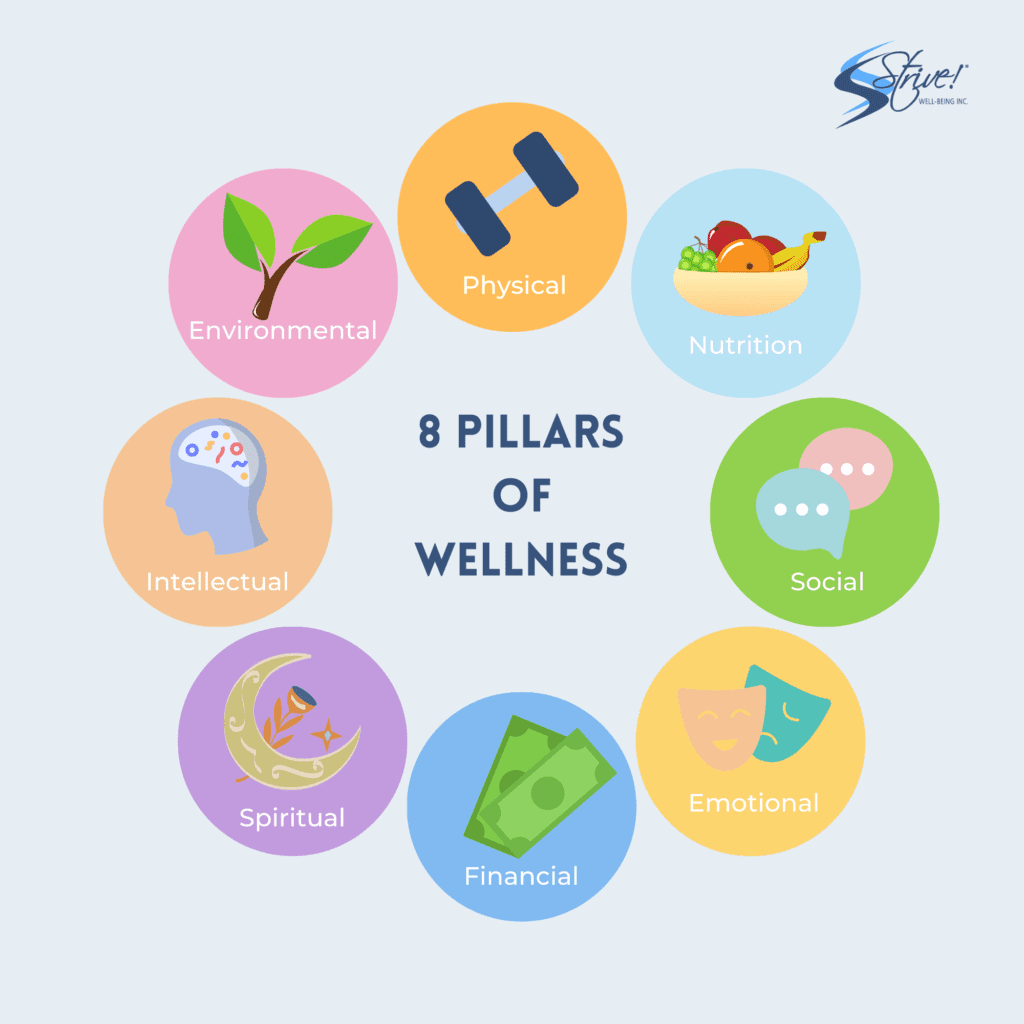What are the 8 Pillars of Wellness?
Fulfillment may look different to each person, but the path to reach it is the same — the pursuit of wellness. There are eight pillars, or dimensions, of wellness that encompass total well-being. The more each pillar is developed, the more fulfillment a person experiences as they grow into the best version of themselves.
This article discusses the eight dimensions of holistic wellness: physical, nutrition, social, emotional, financial, spiritual, intellectual, and environmental, as well as suggestions for how each can be developed further.
8 Dimensions of Wellness
In this post:
Physical Wellness
The physical pillar of wellness concentrates on maintaining your health and reducing risk of illness or disease. Regular body movement like stretching and exercise keep us strong and release mood-boosting endorphins while a nutritious diet supports healthy internal and external functions. Physical health also allows us to connect with others as we participate in activities like sports or hikes together.
Equally essential is hygiene and prioritizing quality sleep. Everyday activities as simple as brushing your teeth are necessary for overall physical health, and forming healthy sleep habits like avoiding screen time before bed can significantly improve your physical wellness.
Organizations can help employees work towards their physical wellness goals by offering fitness classes, opening or providing discounts for fitness centers, or initiating wellness challenges such as taking the stairs instead of the elevator, or a competition for who can get a full 7-8 hours of sleep per night in a week.
Nutritional Wellness
While nutrition is intertwined with physical health, it’s vital enough to be expressed by its own pillar. A balanced diet varies from person to person, but it’s generally made up of fruits, vegetables, grains, protein, and dairy. Incorporating a proper nutritional diet helps diminish the risk of chronic illnesses over time, allows us to appreciate what our bodies do for us, and replaces fatigue with energy.
Individuals can develop the nutrition pillar by refraining from foods high in trans fats, saturated fats, added sugar, and cholesterol, and being mindful about a balanced diet and portion sizes. In the workplace, organizations can be intentional about cafeteria or vending machine offerings, or offer healthy cooking demos and health talks covering topics such as supermarket survival or healthy snack ideas to promote the nutrition pillar in their workforce.
Social Wellness
Social wellness refers to a sense of belonging and security in the world, fostered through connections you make with others. Because we’re social beings by nature, it’s essential to have authentic friendships and relationships to learn how to communicate and resolve conflict in a healthy way. Especially in times of intense stress or hardship, it’s vital to have a support system to nurse you back to feeling socially well.
In a workplace setting, it’s important for leadership (upper and middle management) to foster authentic relationships with their employees. With leadership’s vocal support, social wellness can be encouraged through employee recognition programs, company retreats, or organized activities outside of work that encourage employees to form connections.
Emotional Wellness
The emotional wellness pillar speaks to one’s ability to feel in control of their emotions. This requires developing emotional intelligence, or being able to understand, navigate, and communicate your emotions — especially in times of stress or pressure. The emotional aspect of holistic wellness is critical as it impacts your ability to feel generally positive about life, have habitually healthy thoughts, and avoid a bad conscience.
Employee assistance programs, stress management programs, or personal development classes are examples of how employers can help employees develop emotional wellness.

Financial Wellness
Almost everyone has faced financial stress at one point or another. Finances can either be a solid anchor or a detriment to one’s physical and emotional wellness. Financial wellness is the pillar that encourages a person to plan for the future and not spend more than they have. Most of us have to learn financial competencies like saving money or setting and sticking to budgets.
Employees can develop financial wellness by choosing organizations that offer competitive benefits and/or have employee savings programs or financial wellness training.
Spiritual Wellness
While the pillar of spiritual wellness is unique to each person, it refers to fostering a connection to one’s higher power and/or purpose, often through a belief system, prayer, meditation, or other activities that align with one’s personal values. Spiritual wellness helps one face life’s most difficult moments with resiliency and inner peace.
Organizations can offer mindfulness programs including meditation or yoga to help employees develop their spiritual wellness.
Intellectual Wellness
The intellectual pillar is developed when one embraces experiences that stimulate their mind. Learning new skills, acquiring new interests, or collaborating and sharing ideas with others are all opportunities to engage your mind and practice intellectual wellness. Characterized by finding enrichment personally and professionally, intellectually healthy people are always seeking opportunities for growth.
Retention rates are 34% higher in organizations that provide employee development opportunities. Attending lunch and learn sessions, utilizing a workspace that encourages collaboration, or participating in mentorship programs are all ways employees can pursue the intellectual dimension of wellness.
Environmental Wellness
The pillar of environmental wellness characterizes the relationship between an individual and their surroundings, whether that be home, work, or the community. Maintaining a clean space, having nutritious food on hand, and paying attention to lighting and air quality are all solutions to creating a space that supports wellness.
In an office setting, organizations can utilize wellness design and ergonomic furniture, practice recycling, or organize a volunteer clean-up day to develop employees’ environmental wellness. They can also create an environment conducive to wellness by providing mostly nutritious options in cafeterias, kitchens, and vending machines.
Other integral aspects of environmental wellness in the workplace are leadership support, policies and procedures that promote safety such as evacuation/preparedness plans and safety protocols, and wellness spaces for employees to unwind and refocus.
Strive Wellness Programs
Strive helps clients design and implement comprehensive wellness programs with offerings that address all eight dimensions of wellness. Our turnkey wellness services alleviate administrative burdens so the organization’s wellness team or representative can focus on big-picture strategy and initiatives. With fully-burdened pricing including programming, an account manager, and a technology platform — Strive takes care of the heavy-lifting and makes wellness easy.
Book a discovery call with one of our wellness experts to explore the possibilities for your organization.



